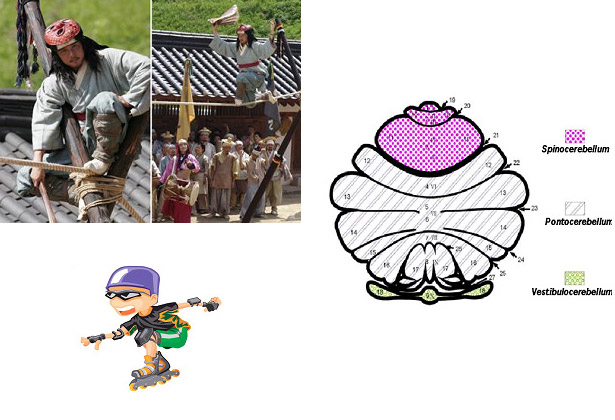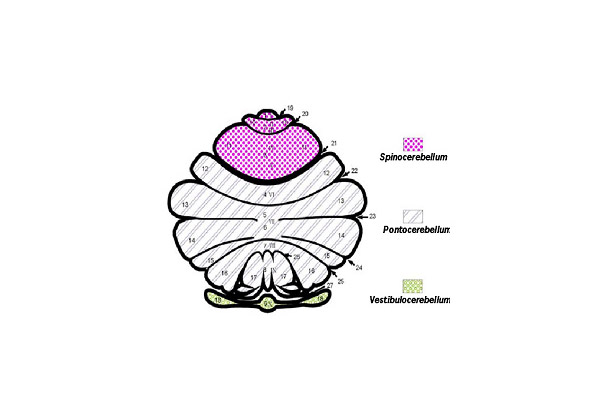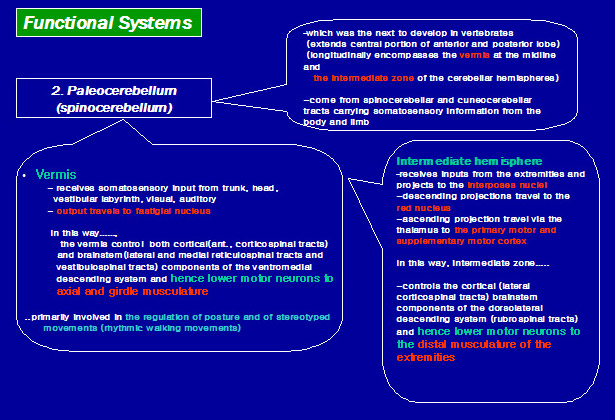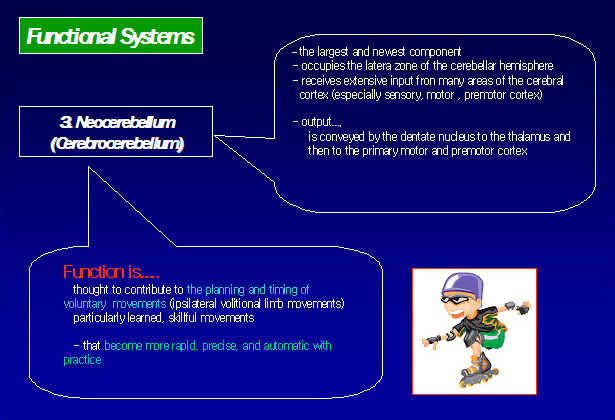The cerebellum is...
firsh-sized, transverdely fissured mass of the central nervous system tissue attached th the dorsum of the pons by peduncles.
Massive amounts of sensory information enter the cerebellum, and cerebellar output is vital for normal movement...
Neuron Fantasy...
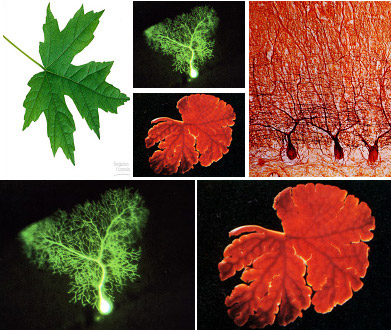
The cerebellum is a small structure that lies on the dorsal side of the brain stem and comprise about 10 % of the total mass of the brain.
It lies dorsal to the pons and medulla, forming the roof of the forth ventricle
Simplest and most primitive function of the cerebellum is……
mediated by brainstem connections involving of vestibulo-ocular reflexes and other reflex components of equilibrium
and balance.
modulation of skilled voluntary movement involving the muscles of the distal extremities and speech Involving early
stages of the planning and initiation of movement
Tremendous amount of afferent input…, in fact, afferent fibers outnumber efferent by about 40 to 1. Afferent inputs to the cerebellum originate in the spinal cord, as well as in many regions of both
The cortical and subcortical brain.
- afferents terminate primarily within the cerebellar cortex,
- within the cerebellar cortex, these fibers lose their myelin sheath and end either as mossy fibers or climbing fibers.
1. Anatomy of cerebellum
-
A. located in posterior cranial fossa
- Molecular Layer
- Purkinje Cell Layer
- Granular Layer
-
B. Longitudinal division
- Vermis, Paravermal Region, Cerebellar Hemisphere
-
C. Transverse division
- Anterior Lobe
- Posterior Lobe
- Flocculonodular Lobe
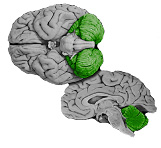
Cerebellar Internal Configurations
-
Cerebellar Cortex
- Molecular Layer
- Purkinje Cell Layer
- Granular Layer
- Corpus Medullare (Medullary Center)
-
Deep Cerebellar Nuclei
- Fastigial Nuclei(1)
- Nucleus Interpositus
- Emboliform Nucleus(3)
- Globose Nucleus(2)
- Dentate Nucleus(4)
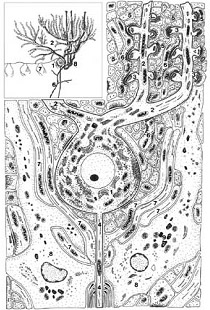
I. Molecular Layer
-
Stellate Cell --- taurine (inhibitory)
- afferent: parallel fiber
- efferent: Purkinje cell dendrite
-
Basket Cell ---- GABA (inhibitory)
- afferent: parallel fiber
- efferent: Purkinje cell soma
-
Parallel Fiber
- granule cell axon
- Purkinje Cell Dendrite
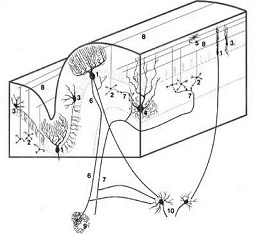
I. Molecular Layer
- Purkinje Cell
- 15,000,000 in number
- GABA (inhibitory)
- afferent:
- parallel fiber
- climbing fiber
- stellate cell
- basket cell
- efferent: deep cortical nuclei
- Bergman's glial cell
III. Granular Layer
- Granular Cell
- 50,000,000,000 in number
- glutamic acid (excitatory)
- afferent: mossy fiber
- efferent: Purkinje cell dendrite
basket cell, stellate cell
Golgi cell
- Golgi Cell
- GABA (inhibitory)
- afferent: parallel fiber, mossy fiber rosette
- efferent: granule cell dendrite

Cerebellar Connections
A. Afferent Connections
- Inferior Cerebellar Peduncle
- Restiform Body
- Posterior Spinocerebellar Tract
- Olivocerebellar tract
- Cuneocerebellar Tract
- Reticulocerebellar Tract
- Juxtarestiform Body
- Vestibulocerebellar Tract
- Primary Vestibular Fiber
- Restiform Body
- Middle Cerebellar Peduncle
- Pontocerebellar fiber
- Corticopontocerebellar Fiber
- Reticulocerebellar Fiber
- Superior Cerebellar Peduncle
- Anterior Spinocerebellar Tract
- Cerulocerebellar fiber
- Raphecerebellar fiber
- Rubrocerebellar fiber
- Hypothalamocerebellar fiber
- Anterior Spinocerebellar Tract
B. Efferent Connections
- Superior Cerebellar Peduncle
- Cerebellothalamic fiber
- from 3 deep nuclei to VPLo, VLc, CL
- Cerebellorubral fiber
- from nucleus interpositus and dentate nucleus
- ascending portion of
- uncinate fasciculus of Russell
- Cerebellothalamic fiber
- Inferior Cerebellar Peduncle
- Fastigiovestibular fiber
- descending portion of uncinate fasciculus of Russell
- Fastigiovestibular fiber
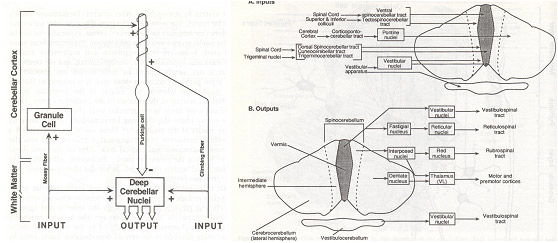
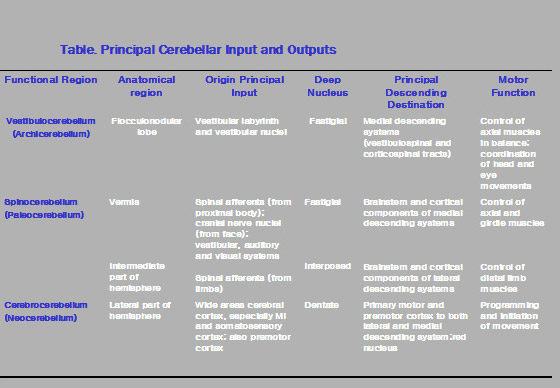
Cerebellar Function
- Maintenance of Equilibrium
- balance, posture, eye movement
- Coordination of half-automatic movement of walking and posture maintenance
- posture, gait
- Adjustment of Muscle Tone
- Motor Leaning - Motor Skills
- Cognitive Function
Role of the Cerebellum in Overall Motor Control
1. Posture and Equilirium
- Vestibular interconnections mediate an important role for the cerebellum in coordination of head and eye movements, as well as in the maintenance of body equilibrium and posture.
- The cerebellum particularly important in the maintenance of equilibrium during movement (locomotion)
- uses feedback from the vestibular system to determine changes occurring in the direction of motion
Lesion in Flocculonodular lobe and Vermis
result in disturbance of equilibrium(.....particularly evident during rapid changes in body position or in the direction of monement)
patients with such lesions mayexhibit
- unsteadiness of gait
- inability to stand
- inability to sit without sw aying or falling
- abnorm alities of eye monement such as nystagmus
Note...Destruction of archicere bellum
- little change in muscle tone
- no trem or
- dyssynergy in distal extremities
2. Skilled Voluntary Movement
Cerebellum.. plays important roles
- coordination of skilled movement
- planning of skilled voluntary movement, most of which involve the musculature of the distal extremities.
….is
- able to detect discrepancies between two
- corrective measures to minimize the "errors"
In this way…..cerebellum
- promotes the kind of synchrony and accuracy of movements (performance of precise, purposeful movements)
- affects of many movement (rate, range, force, direction)
Cerebellum....
....seems to play a central role in both the ordering and the proper timing of the initiation and term ination of the many sequential motor steps required in most purposeful movements
Lesions....
- inability to progress in orderly
- inability to progress in timely fashion from one movement to the next
- disturbance of complex motor activities(running, writing, speaking)
3. Locomotion and Other Rhythunic Activities
Cerebellum.. plays important roles in
- control of certain primitive, rhythmic motor behavior
- control of locomotion including adjustment of the timing of locomotive movements
- modulation of interlimb coordination during locomotion
- coordination of various spinal reflexes with ongoing locomotor activity
….Provides important internal feedback to locomotor pattern generators in the spinal cord
4. Muscle tone
- Removed cerebellum in experimental animal (monkey) studies….
- occurs of hypotonia in limb muscles
- Gamma efferent discharge is influenced by various components of the CNS, one of which is the cerebellum
- thought to have a excitatory influence on the underlying gamma support of the stretch reflex
- Damage to cerebellum…..
- 1. results in decreased excitation of gamma motor neurons
- 2. leading to reduced sensitivity of muscle spindle
- 3. decreased muscle tone
- Cerebellum Clinical Syndromes
- Ataxia: incoordination of movement
- decomposition of movement
- dysmetria, past-pointing
- dysdiadochokinesia
- rebound phenomenon of Holmes
- gait ataxia, truncal ataxia, titubation
- Intention Tremor
- Hypotonia, Nystagmus

